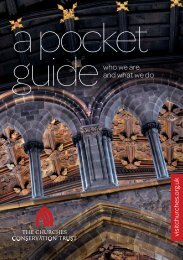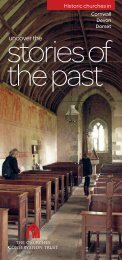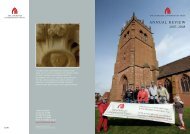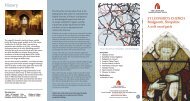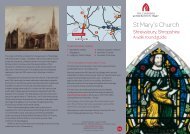Read a report about the clock repair
Read a report about the clock repair
Read a report about the clock repair
You also want an ePaper? Increase the reach of your titles
YUMPU automatically turns print PDFs into web optimized ePapers that Google loves.
Stapleford Church Clock RestorationRichard WhiteCEng MIMechE MBHIDesigner and manufacturer of <strong>clock</strong> auto-wind andregulation equipment. Maintenance and <strong>repair</strong> ofchurch and tower <strong>clock</strong>s.www.richardwhite<strong>clock</strong>s.co.uk63 Main Street Smeeton Westerby Leicestershire LE8 0QJ0116 240 4005 0781 396 2912 Richard@RTWhite.com
IntroductionThe <strong>clock</strong> is of a ‘chair frame’ construction by Whitehurst of Derby and is dated 1773. It waslast overhauled in 1971 but according to local information, has not been allowed to run for manyyears because it was a very erratic timekeeper.Automatic winding equipment was fitted after <strong>the</strong> restoration and <strong>the</strong> newly restored <strong>clock</strong>mounted on a custom made steel bench. Each side of <strong>the</strong> bench was fitted with specialsupports to hold <strong>the</strong> old winding barrels which had been removed in order to allow access for<strong>the</strong> drive chains of <strong>the</strong> automatic winder.RestorationThe photograph left shows<strong>the</strong> <strong>clock</strong> prior to <strong>the</strong> recentrestoration. The drivechains for <strong>the</strong> automaticwinder are visible and oneof <strong>the</strong> original windingbarrels can be seen on <strong>the</strong>lower left hand side of <strong>the</strong><strong>clock</strong> resting on a speciallymade bracket.General ConditionThe overall condition of <strong>the</strong> <strong>clock</strong> was good considering <strong>the</strong> time for which it had beenunattended. Mechanically, it was probably as good as it was shortly after <strong>the</strong> 1971 restorationand <strong>the</strong>re were no serious mechanical issues to deal with.The frame had been painted in a ra<strong>the</strong>r bright green colour which in my opinion was notappropriate for an eighteenth century <strong>clock</strong>. The winding barrels appeared to have beenuntouched during <strong>the</strong> last restoration and <strong>the</strong>re are small fragments of what may be <strong>the</strong> originalpaint finish on <strong>the</strong>m.The custom made steel bench was still very sound but in need of a thorough rubbing down andre-painting. There were no parts of <strong>the</strong> old auto wind system which could be used so this wasremoved.
Clock RebuildThe <strong>clock</strong> was removed from its supporting metal bench and taken to my workshop where it wascompletely dismantled. After jet cleaning, all <strong>the</strong> mechanism was reassembled and tested and<strong>the</strong>n dismantled again. All <strong>the</strong> painted components were <strong>the</strong>n recoated with black paint which Iconsidered to be a more appropriate finish for this age of <strong>clock</strong>. The original green was notremoved as <strong>the</strong>re may have been traces of <strong>the</strong> original finish beneath which would have beenlost by chemical stripping.The winding barrels were thoroughly cleaned and <strong>the</strong>n coated with micro-crystalline wax. All <strong>the</strong>o<strong>the</strong>r metal components, both painted and unpainted, have been coated with <strong>the</strong> samepreparation.Automatic DrivesThe automatic <strong>clock</strong> drives that I manufacture drive <strong>the</strong> <strong>clock</strong> through <strong>the</strong> original drive train byfixing to <strong>the</strong> <strong>clock</strong> winding square. Torque is applied to <strong>the</strong> drive chassis by a cord attached toa spring. As <strong>the</strong> <strong>clock</strong> mechanism moves, <strong>the</strong> barrels rotate. When this rotation is greatenough, an angle sensor on <strong>the</strong> drive switches on <strong>the</strong> drive motor which repositions <strong>the</strong> driverchassis thus continuing to provide torque to <strong>the</strong> winding barrel through <strong>the</strong> winding square.The photograph above left shows <strong>the</strong> automatic drives attached to <strong>the</strong> two <strong>clock</strong> windingbarrels. Nylon cords are attached to each of <strong>the</strong> drives and <strong>the</strong>se pass over pulleys at <strong>the</strong> endof <strong>the</strong> <strong>clock</strong> bench. Each cord is <strong>the</strong>n fixed to a vertically mounted spring attached to <strong>the</strong> <strong>clock</strong>room floor. The springs are shown in <strong>the</strong> photograph on <strong>the</strong> right.
Time RegulatorThe method of time regulation employed on this installation is a ‘pendulum capture’ system.The principle of this is that <strong>the</strong> <strong>clock</strong> is set to run permanently fast and <strong>the</strong>n <strong>the</strong> time is checkedeach hour and <strong>the</strong> pendulum held for <strong>the</strong> appropriate time to correct it. Because <strong>the</strong> correctionis made each hour, <strong>the</strong> error is very small. Additionally, <strong>the</strong> pendulum stopping mechanism canbe used to make <strong>the</strong> biannual time changes for summertime and wintertime by stopping <strong>the</strong>pendulum for a period of eleven hours or one hour.The equipment is controlled with a small microprocessor contained in <strong>the</strong> control box beneath<strong>the</strong> <strong>clock</strong> table. The timing is controlled in accordance with <strong>the</strong> MSF radio time signal and this isreceived by a small box mounted on <strong>the</strong> wall in <strong>the</strong> <strong>clock</strong> room. This is separate from <strong>the</strong> controlbox in order that it can be positioned for <strong>the</strong> optimum signal reception.The photograph left shows <strong>the</strong>regulator’s articulated arm actuallyhold <strong>the</strong> pendulum to stop <strong>the</strong> <strong>clock</strong>.After <strong>the</strong> appropriate time, <strong>the</strong> armwithdraws and <strong>the</strong> pendulumcontinues to swing.The arm is mounted on <strong>the</strong> controlbox beneath <strong>the</strong> <strong>clock</strong> and this alsocontains <strong>the</strong> power supply for <strong>the</strong>automatic <strong>clock</strong> drives.The photograph left shows <strong>the</strong>magnetic switch sensor whichdetects <strong>the</strong> moment at which <strong>the</strong><strong>clock</strong> strikes <strong>the</strong> hour. The switch isattached to <strong>the</strong> <strong>clock</strong> frame with aspecial clamp to avoid any drilling oro<strong>the</strong>r defacement of <strong>the</strong> original<strong>clock</strong> frame.A similar switch and arrangement isemployed to detect <strong>the</strong> position of<strong>the</strong> pendulum in order that <strong>the</strong>articulated ‘capture’ arm will stop<strong>the</strong> pendulum without any danger ofdamage to <strong>the</strong> <strong>clock</strong> mechanism.
Night Strike ControlThe system of night strike control chosen for this installation was one which stopped <strong>the</strong> actualstrike mechanism of <strong>the</strong> <strong>clock</strong> ra<strong>the</strong>r than interrupting <strong>the</strong> drive to <strong>the</strong> bell. Because <strong>the</strong> <strong>clock</strong>strike mechanism is of a ‘count wheel’ type, it must be stopped for 12 complete hours in orderthat <strong>the</strong> <strong>clock</strong> does not lose its synchrony with <strong>the</strong> strike.This was achieved by fitting a small collar to <strong>the</strong> strike ‘fly’ shaft which has a small lug attachedto it. The strike is <strong>the</strong>n disabled by an electromagnetically raised cam which engages with or isheld away from <strong>the</strong> lug thus preventing it from rotating.Pictured left is <strong>the</strong> electro-magneticallycontrolled fly shaft ‘brake’. This deviceis also fitted to <strong>the</strong> <strong>clock</strong> frame with aspecially made clamp to avoiddefacing <strong>the</strong> <strong>clock</strong> frame.The picture below shows <strong>the</strong>completed <strong>clock</strong> toge<strong>the</strong>r with itsautomatic drives and renovatedsupporting bench.Richard White 22 nd January 2012






